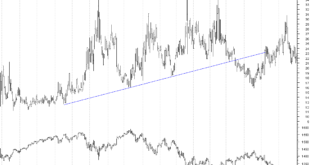In case you think things are going to revert back to normal and the bull market is going to resume, I want to share with you a real world example of what happens when the credit cycle rolls over and it’s systemic implications for the economy and corporations. For the last year I have been listening to folks relentlessly telling me that credit is fine ex-energy. What many fail to understand is that when one sector becomes diseased it eventually spreads to other sectors as well. Credit in energy does not exist in a vacuum and eventually it’s stress is causing other sector’s spreads to widen. This happened during the 2000 telecom credit implosion and the 2007 subprime credit implosion. It is simply the credit cycle and contagion in one sector always starts where the most amount of excess has occurred and eventually spreads to all sectors.
The example I will use to illustrate this point is Cypress Semiconductor which reported earnings last Thursday. On their call it came out that instead of issuing a bond to buy back stock they will cut production and sell chips from inventory to generate cash for the buy back. This has the effect of lowering their gross margins. They did this because in November the cost of the bond was 4% but by January it had risen to 6%. Essentially a 50% increase for an investment grade company in the span of 2 months. If you multiply this anecdote across the whole system you can see that the days of credit milk and honey for companies have ended. The stock buy back math no longer works so we just lost the most important bid in the market. Stock buybacks will now have to come from cash flow. The increase in the cost of money for companies is a profound change that has negative feedback implications for the economy and stock prices.
TJ Rodgers on his company’s buyback:
We’ve decided to actually increase the under-loading to 50% under-loading, which will have an impact on our gross margins. That’s the reason we’re forecasting 36% gross margin in Q1 and low numbers for Q2 and Q3 as well in order to burn through that inventory. We will recover gross margin simply by filling the fab back up to the rate at which we’re consuming inventory, even at the low quarter one level.
We decided to do that, even though reporting – forecasting 36% gross margin is painful, because the alternative for getting cash in order to do our buyback, which we’re committed to – these prices are very attractive, and we’re going to take stock out of the market. The alternative for getting cash to do our buyback is to borrow money and the price for that money – and that was our plan we told you about – the price for that money right now is 6%. And it’s up from about 4%, which is what we baked into our plans when we said we were going to do a buyback. So, we’re in effect going to turn wafers into stock and we’re going to bring stock back without borrowing money. And that’s the plan and we’re eating it on gross margin and we apologize for that announcement this morning.
If you enjoy the content at iBankCoin, please follow us on Twitter






Blue, you’re 100% right… I will say initially it was credit only. However, it has 100% spread… winners sold to help balance the ship from the damage the losers have caused. BBB spreads also pretty much at Euro crisis 2011 levels too.
Nice article, that was well worth the wait. Would you say the cost of borrowing is going up for all companies? Can you really extrapolate this example across all companies and declare buybacks dead?
-was reading just that:
http://www.zerohedge.com/news/2016-02-01/these-are-still-most-disturbing-charts-stock-market
Where things get worse is that as JPM notes, “the increase in HY credit spreads is not just because of Energy, all 21 subsectors have seen widening; US lending standards are tightening again” and in fact “HY spreads have doubled over the past year, with broad participation.”
Why would these companies keep buying back stock in the face of a bear market? If they applied some basic TA to their stock, its apparent that its better to wait for capitulation. Why not spend that profit on shoring up their business, battening down their financial hatches, raise cash etc. This corporate buy back mania seems ridiculously foolish.
North Beach Capital
Someone with some knowledge should answer that. Until then, this will have to suffice:
You are right. It’s foolish, unless you receive incentive pay for increasing EPS.
The stock buy back binge is all about raising EPS while earnings are flat or lower.
The excuse that these are ‘very attractive prices’ is mostly horse s***.
narwhal,
yes I can. look at their balance sheet. a 50% increase is not company specific for an investment grade company.